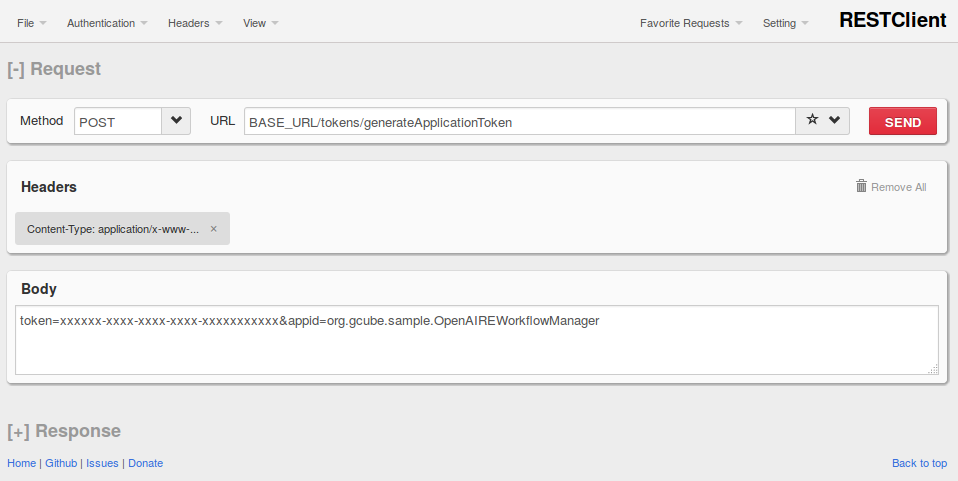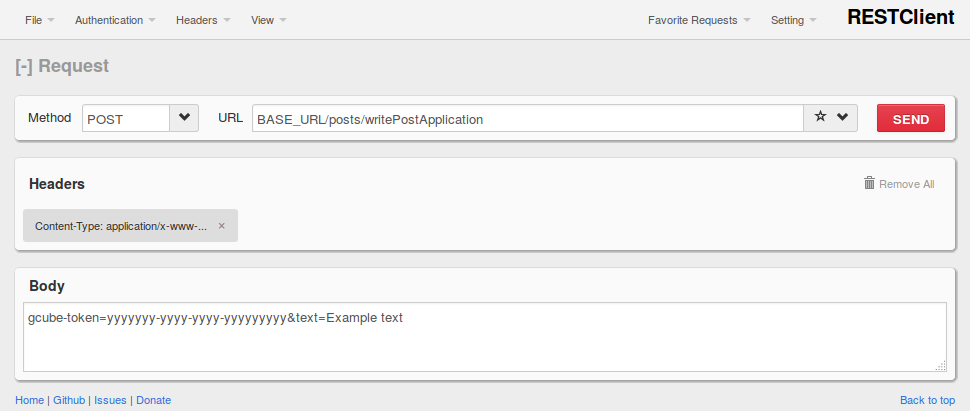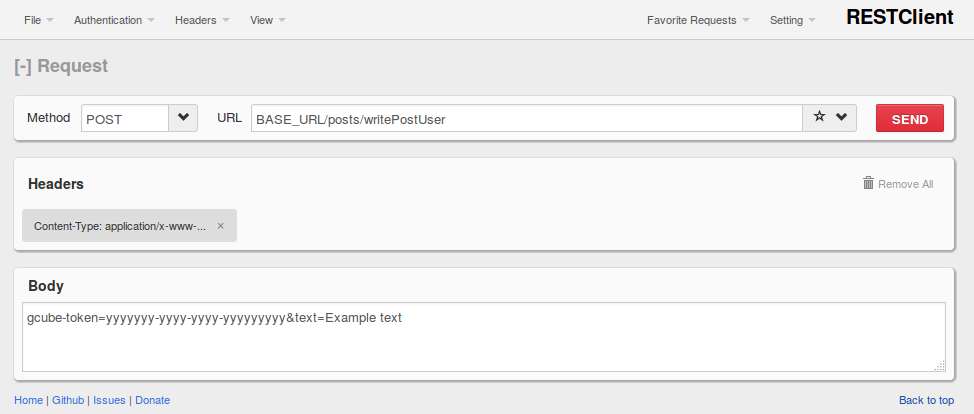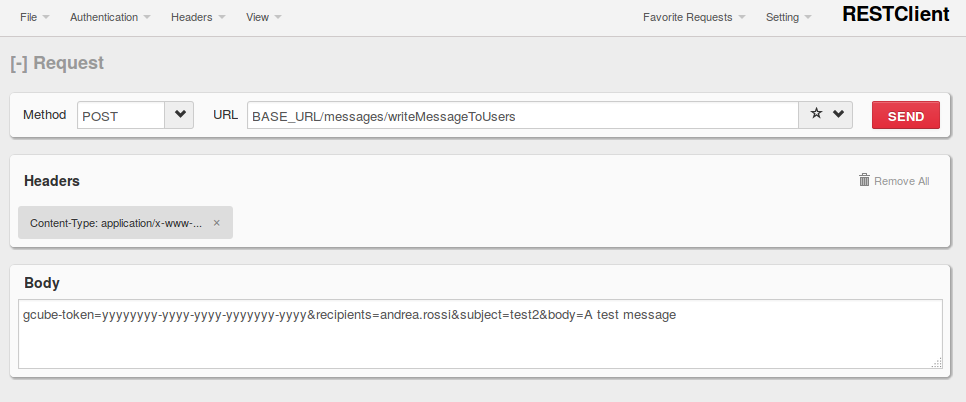Social Networking Service
Contents
- 1 Service Overview
- 2 Discover the Web Service
- 3 Service versions
- 4 Authorization
- 5 Usage
- 6 Service methods (Version 1)
- 6.1 List of available Sub-Services and methods
- 6.1.1 Tokens
- 6.1.2 Posts
- 6.1.2.1 Write application post
- 6.1.2.2 Retrieve all application posts
- 6.1.2.3 Retrieve all user posts
- 6.1.2.4 Retrieve all user posts since a given date
- 6.1.2.5 Retrieve all user posts up to a given quantity
- 6.1.2.6 Write user post
- 6.1.2.7 Retrieve the identifiers of the posts a user liked
- 6.1.2.8 Retrieve the posts a user liked
- 6.1.2.9 Retrieve all vre posts
- 6.1.3 Notifications
- 6.1.4 Messages
- 6.1.5 Users
- 6.1 List of available Sub-Services and methods
- 7 Service methods (Version 2)
- 7.1 List of Available Sub-Services
- 7.1.1 Tokens
- 7.1.2 Full text search
- 7.1.3 Hashtags
- 7.1.4 Posts
- 7.1.4.1 Write application post
- 7.1.4.2 Write user post
- 7.1.4.3 Retrieve all application posts
- 7.1.4.4 Retrieve all user posts
- 7.1.4.5 Retrieve all user posts since a given date
- 7.1.4.6 Retrieve all user posts up to a given quantity
- 7.1.4.7 Retrieve the identifiers of the posts a user liked
- 7.1.4.8 Retrieve the posts a user liked
- 7.1.4.9 Retrieve all vre posts
- 7.1.4.10 Get posts by hashtag
- 7.1.5 Comments
- 7.1.6 Notifications
- 7.1.7 Messages
- 7.1.8 Users
- 7.2 Troubleshooting
- 7.1 List of Available Sub-Services
Service Overview
The Social Networking Web Service is a RESTful application which exposes operations coming from both the gCube Social-Networking-Library and the User Management components. The former is the bridge between the Cassandra Cluster (on which social data are stored) and the social applications, whereas the latter is the abstraction layer over the enabling technology of the Infrastructure portals, Liferay, in terms of: roles, users and organizations and how they are mapped to gCube concepts (VREs, Teams, and so on).
The web services exposes a subset of such functionalities over https in a standard, reliable and secure way.
Discover the Web Service
For gCube releases older than 4.3, a Service Endpoint that has
Name = SocialNetworking Category = Portal
mantains the base path of the service. Starting from gCube 4.3 version, the service runs on SmartGears, thus a gCore Endpoint needs to be searched having
Service Name = SocialNetworking Service Class = Portal
The base path is the entry point of the web service. In the development environment, its current value is
https://socialnetworking-d-d4s.d4science.org/social-networking-library-ws/rest
This url is referred as BASE_URL.
Service versions
Starting from gCube 4.3, the service exposes its methods using a more standard naming approach. Moreover, they accept (in case of http POST/PUT methods) JSON objects. The result of all methods is always a JSON object of this kind
{"success": false/true,
"message": ...,
"result": ...,
}Where
- success reports if the request succeeded or failed;
- message is a status/error message that can be checked in case of errors (success equals false);
- result is the current result object (it can be a list, a single object and so on depending on the invoked method).
Inputs are automatically validated before the request is served.
The older version instead has some limitation thus you are kindly suggested to no longer use it. However, in the following, its methods are going to be reported as well. The older version will be removed starting from the next gCube releases.
Authorization
Despite the versions of the service, every call to one of its method require a gcube-token. See here for more information about this token. This secret token needs to be valid in the current context. It can be put as query parameter of the http request or within the header. Both approaches are valid. If the token is missing, the operation will be rejected and an http forbidden code will be returned.
Usage
The methods of the Web Service can be called by writing your own REST client application or by using (a lot of) already existent rest client plugins. In the following, we will use the RESTClient plugin for Firefox for POST methods. Your browser can be used for GET methods. The return value of each method is an HTTP Response object that has an HTTP CODE (200, 201, 400, 500, ...) and, optionally, a JSON or text object that represents the created/retrieved resource or better specifies the occurred error. In case of errors, please refer to the Troubleshooting section for more details.
Service methods (Version 1)
In the following, the list of available sub-services available under the first version, its methods and the parameters they need in order to be called are reported. The gcube-token is always required so it won't be reported as parameter.
List of available Sub-Services and methods
Tokens
Generate application token
The link to append to Base_URL is the following:
tokens/generateApplicationToken
First of all, you need to have a user gcube-token for authentication purposes. You can get it using the Token Generator portlet available on the VRE you are interesting the app will post in. Now, to get an application gcube-token you can invoke the method. It is an HTTP/POST method that accepts as parameters:
- appid: the identifier of the application as reported in the Application Profile.
For example, using the RESTClient plugin for Firefox you will have something like this for requiring a new application token:
Push on the SEND button and if all it's ok, your application gcube-token will be generated and returned as plain text in the response within the HTTP response having code 201.
Posts
Write application post
The link to append to Base_URL is the following:
posts/writePostApplication
By means of the application token requested with the above method, the app can write on the VRE for which the token has been previously requested. Just invoke this method, that accepts these parameters:
- text: text of the post;
- params: additional parameters if your application supports the direct opening of of this update's object e.g. id=12345&type=foo [optional];
- previewtitle: a title for the preview of the post [optional];
- previewdescription: a description for the preview of the post [optional];
- httpimageurl: if you want to put an image, pass its url [optional];
- enablenotification: a boolean value to enable notifications [optional].
For example:
Push on SEND and check the code associated to the returned response (201 in case of success).
Retrieve all application posts
The link to append to Base_URL is the following:
posts/getAllPostsByApp
In order to retrieve all the posts the application wrote (in every VRE it is allowed to write in) you can invoke this HTTP/GET method.
For example, using your browser:
BASE_URL/posts/getAllPostsByApp?gcube-token=yyyyyyyy-yyyy-yyyy-yyyy-yyyyyyyyy
If all goes ok, the response object has status code 200 and the posts are returned in JSON format.
Retrieve all user posts
The link to append to Base_URL is the following:
posts/getAllPostsByUser
For example, using your browser:
BASE_URL/posts/getAllPostsByUser?gcube-token=yyyyyyyy-yyyy-yyyy-yyyy-yyyyyyyyy
If all goes ok, the response object has status code 200 and the posts are returned in JSON format.
Retrieve all user posts since a given date
The link to append to Base_URL is the following:
posts/getRecentPostsByUserAndDate
If you are interested in retrieving user's posts whose timestamps are greater than a given date you can invoke this method. This HTTP/GET method accepts this parameter:
- time: the time of the oldest post to retrieve converted in milliseconds.
For example, using your browser:
BASE_URL/posts/getRecentPostsByUserAndDate?gcube-token=yyyyyyyy-yyyy-yyyy-yyyy-yyyyyyyyy&time=xxxxxIf all goes ok, the response object has status code 200 and the posts are returned in JSON format.
Retrieve all user posts up to a given quantity
The link to append to Base_URL is the following:
posts/getRecentPostsByUser
If you are interested in retrieving user's posts, starting from the newest up to a given quantity you can invoke this method. This HTTP/GET method accepts two parameter:
- quantity: a value greater than zero (the default value is 10).
For example, using your browser:
BASE_URL/posts/getRecentPostsByUser?gcube-token=yyyyyyyy-yyyy-yyyy-yyyy-yyyyyyyyy&quantity=20
If all goes ok, the response object has status code 200 and the posts are returned in JSON format.
Write user post
The link to append to Base_URL is the following:
posts/writePostUser
By means of a valid user token, he/she can write on the VRE for which the token has been previously requested. Just invoke this method, that accepts these parameters:
- text: text of the post;
- previewtitle: a title for the preview of the post [optional];
- previewdescription: a description for the preview of the post [optional];
- previewHost: [optional];
- previewUrl: [optional];
- httpimageurl: if you want to put an image, pass its url [optional];
- enablenotification: a boolean value to enable notifications [optional];
For example:
Push on SEND and check the code associated to the returned response (201 in case of success).
Retrieve the identifiers of the posts a user liked
The link to append to Base_URL is the following:
posts/getAllLikedPostIdsByUser
By means of this method a user can retrieve the identifiers of the posts he/she liked.
For example, using your browser:
BASE_URL/posts/getAllLikedPostIdsByUser?gcube-token=yyyyyyyy-yyyy-yyyy-yyyy-yyyyyyyyy
If all goes ok, the response object has status code 200 and the identifiers of the posts are returned in JSON format.
Retrieve the posts a user liked
The link to append to Base_URL is the following:
posts/getAllLikedPostsByUser
By means of this method a user can retrieve the posts he/she liked.
For example, using your browser:
BASE_URL/posts/getAllLikedPostsByUser?gcube-token=yyyyyyyy-yyyy-yyyy-yyyy-yyyyyyyyy
If all goes ok, the response object has status code 200 and the posts are returned in JSON format.
Retrieve all vre posts
The link to append to Base_URL is the following:
posts/getAllPostsByVRE
By means of this method a user that has a token valid for a certain VRE, can retrieve all the posts of that VRE. For example, using your browser:
BASE_URL/posts/getAllPostsByVRE?gcube-token=yyyyyyyy-yyyy-yyyy-yyyy-yyyyyyyyy
If all goes ok, the response object has status code 200 and the posts are returned in JSON format.
Notifications
Retrieve user's notifications in a given range
The link to append to Base_URL is the following:
notifications/getRangeNotificationsByUser
By means of this method a user can retrieve his/her last notifications in the range [a, b]. The method requires:
- from: an integer greater than zero;
- quantity: an integer equal or greater than zero.
The final range is evaluated as [from, from + quantity]
For example, using your browser:
BASE_URL/notifications/getRangeNotificationsByUser?gcube-token=yyyyyyyy-yyyy-yyyy-yyyy-yyyyyyyyy&from=from&quantity=quantityIf all goes ok, the response object has status code 200 and the posts are returned in JSON format.
Messages
Send a message
You can send a message via the web service by using the following POST method:
- writeMessageToUsers
The link to append to BASE_URL is
messages/writeMessageToUsers
By default, the sender of the message is the owner of the gcube-token. If you need to specify a different "sender", you can do that by specifying the parameter sender. Furthermore, according to the recipients' notifications preferences, they could receive a portal notification, a mail notification and so on.
Parameters are:
- subject: the subject of the message to send;
- body: the body of the message;
- recipients: a list of valid comma separated users' ids (e.g., andrea.rossi, mario.rossi).
- sender: a valid sender's id [optional]
An example usage of the method is reported in the picture below (without specifying the sender):
Users
Read user's custom fields
You can read user's custom attributes using the following method
- readCustomAttr
The link to append to BASE_URL is
users/readCustomAttr
The read method requires
- attribute: that is the name of a valid attribute to be read.
For example, using your browser:
BASE_URL/users/readCustomAttr?gcube-token=yyyyyyyy-yyyy-yyyy-yyyy-yyyyyyyyy&attribute=attributeXService methods (Version 2)
The list of sub-services available in the new version is going to be reported next. The name convention is different. For instance, to read user's posts, the method to be called is
BASE_PATH/2/posts/get-posts-user/
The real result of the method, if the request succeeded, is contained into the 'result' field of the json object
{"success": ..., "message": ..., "result": "[{first post}, {second post}, ...}In the following, the list of available sub-services available under the newest version, its methods and the parameters they need in order to be called are reported. Again, you can use your preferred REST client so examples won't be reported.
List of Available Sub-Services
Tokens
Generate application token
The link to append to Base_URL is the following:
2/tokens/generate-application-token
First of all, you need to have a user gcube-token for authentication purposes. You can get it using the Token Generator portlet available on the VRE you are interesting the app will post in. Then, to get an application gcube-token you can invoke the method. It is an HTTP/POST method that accepts as parameter:
- a json object of this kind {"app_id": "your-app-id-goes-here"}.
Full text search
Search by query
Social data are indexed into an ElasticSearch engine and are querable using a full-text approach. You can retrieve more information about this index [1]. The link to append to Base_URL is the following
2/full-text-search/search-by-query
The query can be submitted also to the service, by using the following parameters
- query: the query to perform against the index [mandatory];
- from : the result set should be returned by starting from the n-th result [default is zero, optional];
- quantity: how many enhanced posts need to be returned [default is 10, optional].
Hashtags
Get hashtags and occurrences in a context
The link to append to Base_URL is the following
2/hashtags/get-hashtags-and-occurrences
The result is of the kind {"success": true, "message": null, "result":{{"hashtag1" : x}, {"hashtag2" : y}, ...} }
Posts
Write application post
The link to append to Base_URL is the following:
2/posts/write-post-app
By means of the application token requested with the above method, the app can write on the VRE for which the token has been previously requested. Just invoke this method, that accepts these parameters in a JSON object
- text: text of the post;
- params: additional parameters if your application supports the direct opening of of this update's object e.g. id=12345&type=foo [optional];
- preview_title: a title for the preview of the post [optional];
- preview_host: a host for the preview of the post [optional];
- preview_description: a description for the preview of the post [optional];
- preview_url: the preview url [optional];
- image_url: if you want to put an image, pass its url [optional];
- enable_notification: a boolean value to enable notifications [optional, default is false].
Write user post
The link to append to Base_URL is the following:
2/posts/write-post-user
By means of a valid user token, he/she can write on the VRE for which the token has been previously requested. Just invoke this method, that accepts these parameters in a JSON object:
- text: text of the post;
- preview_title: a title for the preview of the post [optional];
- preview_description: a description for the preview of the post [optional];
- preview_host: a host for the preview of the post [optional];
- preview_url: the preview url [optional];
- image_url: if you want to put an image, pass its url [optional];
- enable_notification: a boolean value to enable notifications [optional].
Retrieve all application posts
The link to append to Base_URL is the following:
2/posts/get-posts-app
In order to retrieve all the posts the application wrote (in every VRE it is allowed to write in) you can invoke this HTTP/GET method.
Retrieve all user posts
The link to append to Base_URL is the following:
2/posts/get-posts-user
Retrieve all user posts since a given date
The link to append to Base_URL is the following:
2/posts/get-posts-user-since
If you are interested in retrieving user's posts whose timestamps are greater than a given date you can invoke this method. This HTTP/GET method accepts as parameter:
- time: the time of the oldest post to retrieve converted in milliseconds.
Retrieve all user posts up to a given quantity
The link to append to Base_URL is the following:
2/posts/get-posts-user-quantity
If you are interested in retrieving user's posts, starting from the newest up to a given quantity you can invoke this method. This HTTP/GET method accepts as parameter:
- quantity: a value greater than zero (the default value is 10).
Retrieve the identifiers of the posts a user liked
The link to append to Base_URL is the following:
2/posts/get-id-liked-posts
By means of this method a user can retrieve the identifiers of the posts he/she liked.
Retrieve the posts a user liked
The link to append to Base_URL is the following:
2/posts/get-liked-posts
By means of this method a user can retrieve the posts he/she liked.
Retrieve all vre posts
The link to append to Base_URL is the following:
2/posts/get-posts-vre
By means of this method a user that has a token valid for a certain VRE, can retrieve all the posts of that VRE.
Get posts by hashtag
The link to append to Base_URL is the following:
2/posts/get-posts-by-hashtag
The method requires as parameter:
- hashtag: the hashtag to be contained in the returned posts[mandatory].
Comments
Retrieve comments by user
The link to append to Base_URL is the following:
2/comments/get-comments-user
It is an http GET method.
Retrieve comments by user and time
The link to append to Base_URL is the following:
2/comments/get-comments-user-by-time
It is an http GET method. It requires:
- time: the time (in milliseconds) since when the comments need to be retrieved [default is zero, optional];
Notifications
Retrieve user's notifications in a given range
The link to append to Base_URL is the following:
2/notifications/get-range-notifications
By means of this method a user can retrieve his/her last notifications in the range [a, b]. The method requires:
- from: an integer greater than zero;
- quantity: an integer equal or greater than zero.
The final range is evaluated as [from, from + quantity].
Notify job status
The link to append to Base_URL is the following:
2/notifications/notify-job-status
By means of this method a user can be notified about the status of a job in the infrastructure. Jobs are, for instance, SmartExecutor's plugins or DataMiner's algorithms. The method requires the following parameters in a JSON object
- recipient: the username of the user to be alerted [mandatory];
- job_id: the identifier of the job (e.g, a uuid) [mandatory];
- job_name: the name of the running job (e.g., Social-data-indexer-plugin)[mandatory];
- service_name: the name of the service that launched the job (e.g., SmartExecutor) [mandatory];
- status: the status reached by the job, for instance CANCELLED, CANCELLING, DELETED, DELETING, EXECUTING, FAILED, SUCCEEDED, SUBMITTED, TIMED_OUT, WAITING [mandatory];
- status_message: a detailed message about the status [optional].
Messages
Send a message
The link to append to BASE_URL is
2/messages/write-message
By default, the sender of the message is the owner of the gcube-token. According to the recipients' notifications preferences, they could receive a portal notification, an email notification and so on.
Parameters, to be put in a JSON object are:
- subject: the subject of the message to send;
- body: the body of the message;
- recipients: a list of valid comma separated users' ids (e.g., andrea.rossi, mario.rossi);
Get received messages
The link to append to BASE_URL is
2/messages/get-received-messages
It is an http GET method.
Get sent messages
The link to append to BASE_URL is
2/messages/get-sent-messages
It is an http GET method.
Users
Read user's custom fields
The link to append to BASE_URL is
2/users/get-custom-attribute
The method requires
- attribute: that is the name of a valid attribute to be read.
Get user's email
The link to append to BASE_URL is
2/users/get-email
The method returns the email associated to the owner of the security token used.
Get user's profile
The link to append to BASE_URL is
2/users/get-profile
The method returns the profile of the owner of the security token used.
Get user's fullname
The link to append to BASE_URL is
2/users/get-fullname
The method returns the fullname associated to the owner of the security token used.
Get all users' usernames in VRE
The link to append to BASE_URL is
2/users/get-usernames
The method returns the usernames of the context associated to the security token.
Troubleshooting
There could be many reasons for a failed request. Please always check the HTTP CODE and the message within the response.
This table tries to help you:
| HTTP CODE | Meaning |
|---|---|
| 400 - BAD_REQUEST | Please check the parameters you are passing |
| 403 - FORBIDDEN | Is the token valid? / Does it belong to an application? [In case of application request] |
| 404 - NOT_FOUND | The object(s) you are asking for is(are) not available |
| 500 - INTERNAL_SERVER_ERROR | There was an error while serving your request (retry later) |



